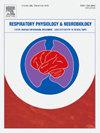环境温度对自主呼吸新生大鼠右美托咪定诱导的代谢和心肺抑制的影响。
IF 1.6
4区 医学
Q3 PHYSIOLOGY
引用次数: 0
摘要
已知新生动物在缺氧条件下,特别是在寒冷环境下,通过减少产热来增加通气代谢比。我们研究了环境温度和α2肾上腺素能受体激动剂右美托咪定引起的体温调节抑制是否影响新生大鼠通气和代谢之间的耦合。测定3 ~ 7日龄Wistar大鼠的代谢和心肺指标。对照记录在34°C环境温度(Ta)下进行,Ta保持在34°C(中),降低到27°C(低)或增加到39°C(高)。到达所需Ta后,给予生理盐水或右美托咪定(50μg∙kg-1),再次记录各项指标。生理盐水组和右美托咪定组之间的控制值具有可比性。使用相对于各组控制值的值,体温(低或高Ta vs.中Ta)和心率(低Ta vs.高Ta)在三Ta之间有显著差异。在每个Ta时,右美托咪定组的代谢率、分钟通气量、呼吸率和心率均明显低于生理盐水组。尽管有这些变化,但与生理盐水组相比,右美托咪定组在中Ta和低Ta时的通气代谢比率相当,在高Ta时显著降低。右美托咪定加阿替帕唑(5mg∙kg-1, α2肾上腺素受体拮抗剂)在低Ta和高Ta时不影响通气代谢比。虽然右美托咪定抑制热调节反应,但α2肾上腺素能感受器在低温而非高温环境下的激活可以维持通气和代谢率的耦合。我们的研究结果表明α2肾上腺素受体的激活损害了新生大鼠在加热或再加热时的通气控制。本文章由计算机程序翻译,如有差异,请以英文原文为准。
Effect of ambient temperature on dexmedetomidine-induced metabolic and cardiorespiratory suppression in spontaneously breathing newborn rats
Newborn animals are known to increase the ventilation–metabolism ratios in hypoxia, particularly at cold environment by decreasing the thermogenesis. We examined whether ambient temperatures and thermoregulatory suppression due to dexmedetomidine, an α2 adrenoceptor agonist, affect the coupling between ventilation and metabolism in neonatal rats. Wistar rats (3–7 days old) were measured for metabolic and cardiorespiratory indices. Control recordings were made at 34 °C ambient temperature (Ta) and Ta was either kept at 34 °C (Medium), reduced to 27 °C (Low) or increased to 39 °C (High). Once at the desired Ta, the rats were administered normal saline or dexmedetomidine (50 μg∙kg−1) and the indices were again recorded. Control values were comparable between the normal saline and dexmedetomidine groups. Using values relative to the control values in each group, body temperature (Low or High vs. Medium Ta) and heart rate (Low vs. High Ta) were significantly different among the three Ta. At each Ta, the dexmedetomidine group showed significantly lower metabolic rates, minute ventilation, respiratory rate and heart rate, compared to the normal saline group. Despite these changes, the ventilation![]() metabolism ratios in the dexmedetomidine group were comparable at the Medium and Low Ta, and significantly lower at the High Ta, compared to the normal saline group. Dexmedetomidine plus atipamezole (5 mg∙kg−1, an α2 adrenoceptor antagonist) did not affect the ventilation–metabolism ratios at the Low and High Ta. Although dexmedetomidine suppresses thermoregulatory responses, the coupling of ventilation and metabolic rates can be preserved through α2 adrenoceptor activation at cold, but not at hot, ambient temperature. Our results suggest that α2 adrenoceptor activation impairs control of ventilation at heating or rewarming in newborn rats.
metabolism ratios in the dexmedetomidine group were comparable at the Medium and Low Ta, and significantly lower at the High Ta, compared to the normal saline group. Dexmedetomidine plus atipamezole (5 mg∙kg−1, an α2 adrenoceptor antagonist) did not affect the ventilation–metabolism ratios at the Low and High Ta. Although dexmedetomidine suppresses thermoregulatory responses, the coupling of ventilation and metabolic rates can be preserved through α2 adrenoceptor activation at cold, but not at hot, ambient temperature. Our results suggest that α2 adrenoceptor activation impairs control of ventilation at heating or rewarming in newborn rats.
求助全文
通过发布文献求助,成功后即可免费获取论文全文。
去求助
来源期刊
CiteScore
4.80
自引率
8.70%
发文量
104
审稿时长
54 days
期刊介绍:
Respiratory Physiology & Neurobiology (RESPNB) publishes original articles and invited reviews concerning physiology and pathophysiology of respiration in its broadest sense.
Although a special focus is on topics in neurobiology, high quality papers in respiratory molecular and cellular biology are also welcome, as are high-quality papers in traditional areas, such as:
-Mechanics of breathing-
Gas exchange and acid-base balance-
Respiration at rest and exercise-
Respiration in unusual conditions, like high or low pressure or changes of temperature, low ambient oxygen-
Embryonic and adult respiration-
Comparative respiratory physiology.
Papers on clinical aspects, original methods, as well as theoretical papers are also considered as long as they foster the understanding of respiratory physiology and pathophysiology.

 求助内容:
求助内容: 应助结果提醒方式:
应助结果提醒方式:


